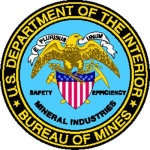- Branche: Mining
- Number of terms: 33118
- Number of blossaries: 0
- Company Profile:
The U.S. Bureau of Mines (USBM) was the primary United States Government agency conducting scientific research and disseminating information on the extraction, processing, use, and conservation of mineral resources.
Founded on May 16, 1910, through the Organic Act (Public Law 179), USBM's missions ...
A chemical element with atomic number greater than 88; all are radioactive.
Industry:Mining
A chemical element with atomic number greater than 88; all are radioactive.
Industry:Mining
A chemical process of separating closely related compounds by permitting a solution of them to filter through an absorbent so that the different compounds become absorbed in separate colored layers comprising a chromatogram.
Industry:Mining
A chemical sedimentary rock composed of calcium carbonate, formed by evaporation as a surficial, spongy, porous, semifriable incrustation around the mouth of a hot or cold spring or seep, or along a stream carrying calcium carbonate in solution, and exceptionally as a thick, bulbous, concretionary or compact deposit in a lake or along its shore. It may also be precipitated by algae or bacteria. The hard, dense variety is travertine. The term is rarely applied to a similar deposit consisting of silica. It is not to be confused with tuff. Etymol: Italian tufo. Compare: sinter petrified moss.
Industry:Mining
A chemical sedimentary rock, typically thin-bedded and/or finely laminated, containing at least 15% iron of sedimentary origin, and commonly but not necessarily containing layers of chert. Various primary facies (usually not weathered) of iron formation are distinguished on the basis of whether the iron occurs predominantly as oxide, silicate, carbonate, or sulfide. Most iron formation is of Precambrian age. In mining usage, the term refers to a low-grade sedimentary iron ore with the iron mineral(s) segregated in 1643 bands or sheets irregularly mingled with chert or fine-grained quartz. Compare: ironstone; jaspilite. Essentially synonymous terms are itabirite; banded hematite quartzite; taconite; quartz-banded ore; banded iron formation; calico rock; jasper bar.
Industry:Mining
A chemical system containing two components, e.g., the MgO-SiO<sub>2</sub>system.
Industry:Mining
A chemical test to disclose the presence of certain metals in a sample. A clear glassy bead of borax fused in a wire loop will react chemically with the salts of certain metals and yield colors that help to identify the metal; e.g., manganese compounds produce a violet bead, cobalt produces a deep blue, etc.
Industry:Mining
